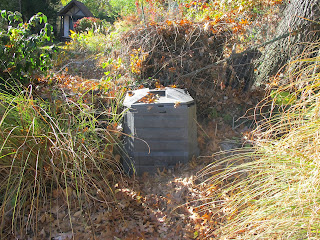Losing daylight but still smiling. :)
I tossed all the non-compostables into a bucket. Mostly fruit stickers, pantyhose, and "compostable" plastic coffee lids.
Once all the finished compost was removed, I placed the bin back in place.
I threw in some leaves and straw-like grass at the bottom. This should provide a nice airy layer at the bottom to keep the pile more aerated.
On top of the straw and leaves I dumped the unfinished compost I pulled off in the beginning. There was some shoveling involved before this container was light enough to pick up (although feel free to think I have herculean-like strength).
In the past I have used 5-gallon buckets for this purpose and I think they were easier to handle.
Finally, I tossed some old tomato vines on top and finished with the lid.
If you have two compost bins, you can skip the removal of the unfinished compost and just wait for it all to compost. I might branch out and try that someday but this method works for me now.
So there you go, harvesting my compost in pictures. I even included an awkward makeup free "compost selfie" since I love you all so much. :)
|

















Great pictorial Michelle! Now I'm ready to tackle the big bin! Happy Thanksgiving!
ReplyDeleteYay, I'm glad you're inspired!
DeleteI use a two bin system, similar to the three bin system you see in many of the composting classes. It works very well for this task, as I just toss unfinished stuff from one into the other, and alternate which I harvest from. Relocating the bins also works well, leaving a pipe behind that is easy to access in the open, versus digging out of a confined space. This works really well if you have a larger yard, smaller yards may not have the space for multiple bins and moving each time you harvest.
ReplyDeleteGreat tip, thanks!
DeleteNice pictorial, Michelle. After piling a lot of raked leaves onto my pile, it felt good to dump some kitchen scraps on top; I think of it as "making lasagna." Keep layering!
DeleteNow with it turning cold I have a nice mix of mulch leaves and grass clipping in my compost bin. I am now adding kitchen scraps- coffee grounds fruits and veg left overs... So have a ??? I read adding urine and ammonia is good to add for moisture and extra nitrogen to activate heat up the compost come spring but wont the urine and ammonia kill or drive away earthworm, microbes and other good stuff or what???
ReplyDeleteGreat question! Urine is very high in nitrogen and many composters use this as a natural nitrogen boost in composting. I have read of no negative effects to the microbial life. You do want to be careful that you do not add too much, nitrogen needs to be balanced with carbon materials and urine can also be high in salt so excessive urine could cause a build up of salt which is bad for the microbs. I have never read anything about adding store bought ammonia, I would be careful with that, I have a feeling that is much more toxic than urine. Just stick with the free natural supply of nitrogen. :)
DeleteHow do you store the finished compost for the winter? Or do you use it right away? Love the step by step photos, and of course the selfie!
ReplyDeleteThanks, Fia. I use the compost right away because you want to get those beneficial microbes into your soil. This year since it was late in the season, I just used it as a top dressing around my plants that I thought could use a boost. You could store it in plastic buckets but most of the good bugs would not survive the winter.
Delete